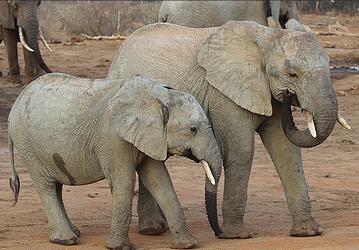
NEW YORK, New York, March 4, 2015 (ENS) – “It’s time to get serious about wildlife crime,” said the United Nations as the second World Wildlife Day was observed around the world this week. The special day was proclaimed by the UN General Assembly in 2013 for March 3, the day of the adoption of the Convention on International Trade in Endangered Species, CITES.
Illegal wildlife trade undermines rule of law, degrades ecosystems and hampers the efforts of rural communities striving to sustainably manage their natural resources, said UN Secretary-General Ban Ki-moon.

“Combating this crime is not only essential for conservation efforts and sustainable development; it will contribute to achieving peace and security in troubled regions where conflicts are fueled by these illegal activities,” said Ban.
On World Wildlife Day, Tuesday, Kenya’s President Uhuru Kenyatta torched 15 metric tonnes of ivory, sending a smoke signal to the world that Kenya continues to reject the international trade in ivory and is a global leader in fighting the ivory trade.
Wildlife and forest crime has grown into one of the largest transnational organized criminal activities, alongside drug trafficking, arms, and trafficking in human beings.
Beyond immediate environmental impacts, the illegal trade in natural resources is depriving developing economies of billions of dollars in lost revenues.
“Getting serious about wildlife crime means enrolling the support of all sections of society involved in the production and consumption of wildlife products, which are widely used as medicines, food, building materials, furniture, cosmetics, clothing and accessories,” the Secretary-General said.
At the Central Park Zoo today, CITES Secretary-General John Scanlon addressed a high-level gathering of experts that includes UN ambassadors from Gabon, Germany and Thailand, saying, “Three human traits that are primary drivers of this illegal trade: greed, ignorance and indifference.”
Scanlon says the positive news is that work is happening to deal with all three issues. “More States are treating wildlife crime as a serious crime; targeted public awareness campaigns are well underway in all regions; and politicians at the highest levels and key opinion leaders are speaking out.”
Moderated by ABC Nightline host Dan Harris, the panel is focusing on the links between wildlife trafficking, organized crime and sustainable development.
The UN agencies are working as one, said Scanlon, and international and national organizations have joined in. Tens of millions of people are being reached through social media.
“We are starting to see the benefits of the collective efforts that are underway addressing the entire illegal supply chain and tackling both demand and supply,” Scanlon said.
“The data released today by CITES MIKE on the reduction in the poaching of elephants in Eastern Africa is tangible evidence of progress,” he said.
“These efforts are supported by the excellent work being done with local communities on livelihoods and engaging them in the fight against wildlife crime, which is a must for success in the longer term,” Scanlon said.
Today, President of the UN General Assembly Sam Kahamba Kutesa will hold an informal session where Member States and the global community will how to step up international efforts to combat wildlife crime at a global scale. Clinton Foundation Vice Chair Chelsea Clinton will deliver opening remarks.
According to new figures released today by CITES, overall elephant poaching rates remained virtually unchanged in 2014 compared to 2013, and still exceed natural elephant population growth rates, meaning a continued decline in elephant numbers overall is likely.
CITES reports that 1,215 rhinos were poached in South Africa alone in 2014 – this translates to one rhino killed every eight hours. Approximately 94 per cent of rhino poaching takes place in South Africa, which has the largest remaining populations. The involvement of organized syndicates has seen poaching rise from less than 20 in 2007 to over 1,000 in South Africa in 2013, and rhino horn poached in 2014 is valued at an estimated US$63 to US$192 million.
The Great Apes Survival Partnership (GRASP) reports that the illicit traffic in live great apes is an increasingly serious threat to chimpanzees, gorillas, and bonobos in Africa and orangutans in Asia, with seizures averaging 1.3 per week since 2014. Many more great apes die during capture and captivity than ever enter the illicit traffic; it is estimated that a minimum of 220 chimpanzees, 106 orangutans, 33 bonobos, and 15 gorillas have been lost from the wild over the last 14 months, according to GRASP.
The Spix’s macaw, the bird portrayed in the animation “Rio” by the friendly character “Blue”, is one of the most endangered species on the planet. Today there are only 80 Spix’s macaws in the world, the majority of which are kept by foreign bird keepers (in Spain, Germany and Qatar).
Pangolins, also known as ‘scaly anteaters’ are among the world’s most trafficked mammals on earth, with over one million animals taken from the wild in the past decade.
The United Nations Development Programme (UNDP) is launching new initiatives to halt the illegal trade in wildlife in Asia and Africa. These initiatives will tackle wildlife crime by focusing on law enforcement, regulations, and engaging the private sector and strengthening collaboration between governments within and across the two regions.
Copyright Environment News Service (ENS) 2015. All rights reserved.
© 2015, Environment News Service. All rights reserved. Content may be quoted only with proper attribution and a direct link to the original article. Full reproduction is prohibited.
